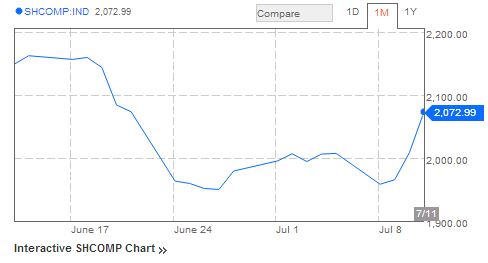By tothetick
It looks as if China’s days of double-digit economic growth are well and truly over (at least, for the moment). Data that will be released next week (second quarter figures) will show a quarter-on-quarter slowdown that is setting in now for China’s gross domestic product. The figures will be issued on Monday, but already it seems as if there will be a rise of just 1.8% for the quarter-on-quarter figures, meaning a 7.5% rise over the past year. There are some analysts that believe however that the figures (as low as they are) are overestimated and we might be seeing an even greater slowdown in GDP growth during this second quarter. So, hold on to your hats.
China: Exports
Figures released yesterday showed that Chinese exports had already fallen by 3.1% in comparison with the same period last year. That was the first fall in data for exports since January 2012. Some had predicted a rise in figures of 4% and so they were way of track. Imports fell by 0.7% in June in comparison with the same time last year. There were estimates of a rise of 8%, which was far from correct. The June import fall was even worse than that for May 2013 (-0.3%). In monetary terms that meant that China’s exports to Southeast Asia dropped by $19.6 billion for June. Exports to the US fell to $29.3 billion (from $31.3 billion in May 2013). The new export-orders sub-index dropped to 45.8 and anything that is under the 50 mark shows a contraction.
The 15th July growth-data release will, according to analysts, show a drop to 7% or 7.5% in GDP growth for the second half of the year. The figures and the news will deal another blow to the Chinese economy which is already seeing troubled times due to the government in China clamping down on shadow-banking and trying to implement stricter regulations and controls. It would seem that there are other factors also that are leading to the slowdown in economic growth in China. They are having to contend with the slow tentative advances in the US economy and also the increasing trouble that is besetting recovery in the EU. Lastly, Abenomics in Japan is showing some promising improvements. That all means that China is going through the mill right now. Japan saw an increase in Q1 GDP growth to 4.1% (which was over what the Japanese government has suggested with their prediction of 3.5%). Industrial production increased in May by 2% in comparison with April’s figure and that was the 4th rise in a row. Retail sales in Japan increased by 0.8% for May also in comparison with May 2012. Despite the fact that it is not all good, the positive side for Japan is having an adverse reaction in China.
India
India
But there may be a silver-lining in the cloud for one country in the world if China’s economy does contract. India! India has relatively limited trade with China. Indian exports (2012-2013) stood at $13, 503 million, while its greatest trade partners are the United Arab Emirates ($36, 265.15 million) and the USA ($36, 152.30 million). India imports far more from China than it actually exports there. The value of imports stands at $54, 324.04 million) meaning that if the Chinese economy does slowdown, it will affect the Indian economy relatively little. But, what will happen is that it will benefit from lower commodity prices that will come about with the slowdown in economic activity in China and a stronger position in negotiations with the PRC.
Commodities
Copper prices
China has been at the heart of the increase in demand for commodities in the world, meaning that prices have tended to become inflated. If there is a reduction in that demand, prices will fall. Commodities are a cause for concern to India since they account for much of their account deficit. India imports 80% of its needs in crude oil presently, meaning that it will be a boost to their economy. China’s demand for commodities in the world has stood at 53% to as high as 111%. That means that while India will be making gains with the fall in prices around the world, those that will see the greatest losses will be suppliers of iron ore, steel or copper.
China consumes roughly 40% of copper in the world alone. The recent statement by Ben Bernanke at the Bureau of Economic Research in Cambridge yesterday that he would not withdraw Quantitative Easing in the foreseeable future had a positive effect on the price of copper. Today copper (to be delivered in September) rose 3.1% (to $3. 1875 / pound) this morning in New York. Copper that will be delivered in November rose 2.9% (to $7, 024 / ton) in London. But the rise today will need to be sustained. Copper is already suffering from an 11% fall this year on the London Metal Exchange. With the figures to be released on Monday from China, it doesn’t look as if much else could happen except consolidate that fall, despite the attempts by the Federal Reserve to calm the markets.
Some are suggesting out there that growth might be far worse than what is being predicted, however. Some are saying that it will be worse than what was experienced by China after the financial crash in 2008.
Shanghai Composite 11th July 2013
Whatever the outcome on Monday regarding the results, the Shanghai Composite didn’t seem to give two hoots as to what was going to be announced. It rallied 3.23% (up 64.87 points to 2, 072.99).
We shall see if the same holds true on Monday when the figures are published and if they are worse than expected.




No comments:
Post a Comment